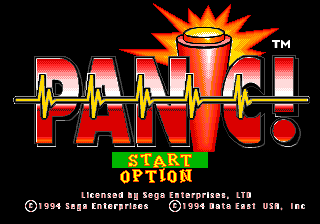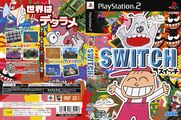Panic!
From Sega Retro
- "Switch" redirects here. For the 2017 video game console by Nintendo, see Nintendo Switch.
| Panic! | |||||||||||||||||||||||||
|---|---|---|---|---|---|---|---|---|---|---|---|---|---|---|---|---|---|---|---|---|---|---|---|---|---|
| System(s): Sega Mega-CD, PlayStation 2 | |||||||||||||||||||||||||
| Publisher: Sega Enterprises, Ltd. (JP) Data East USA (US) Samsung (KR) Sega (JP) | |||||||||||||||||||||||||
| Developer: Office I. Sega CS3,[1], Sega CS2,[2], Sega CS1[3] Wave Master[4], ScriptArts[4], S-Plan[4] | |||||||||||||||||||||||||
| Licensor: Sega Enterprises, Ltd. (US) | |||||||||||||||||||||||||
| Peripherals supported: CD BackUp RAM Cart, Sega Mouse | |||||||||||||||||||||||||
| Genre: Educational[5], Other[5], Adventure[6] | |||||||||||||||||||||||||
| Number of players: 1 | |||||||||||||||||||||||||
|
This short article is in need of work. You can help Sega Retro by adding to it.
Panic!, called Switch (スイッチ) in Japan, is a 1993 point-and-click adventure game by Sega for the Sega Mega-CD. The player controls a cartoon boy who interacts with various different environments to save the world. Each object the player interacts with has a humorous/absurd effect. It is not related to Double Switch, a later Mega-CD game.
Contents
Story
All machines on the planet have suddenly gone haywire as a result of the circuitry on the computer network server becoming riddled by software bugs. A program, codenamed "Panic!" ("Switch" in the Japanese version), was designed to fix the situation and return the world to normal.
All scenes involving pressing buttons feature Slap, a cartoon boy, and/or Stick, a cartoon dog.
Gameplay
The object of the game is to reach the mother computer at the end by pressing switches on different devices and figure out the functions of each switch. When using a Control Pad in the Mega-CD version, the D-Pad is used to move the cursor and the ![]() ,
, ![]() and
and ![]() buttons are used to press switches, while the START button displays the map screen. When using a Sega Mouse, the left mouse button is used for clicking on switches while the right mouse button displays the map screen.
buttons are used to press switches, while the START button displays the map screen. When using a Sega Mouse, the left mouse button is used for clicking on switches while the right mouse button displays the map screen.
Switches have a variety of different effects. Most of them will display a humourous visual gag or have a character say random things to the player, while others will transport Slap/Stick to a different scene. However, some switches are booby-trapped, and pressing a booby-trapped switch will destroy a real-world monument. If all 30 monuments are destroyed, the game ends in failure. The game will also end instantly if the player presses a switch that warps them to a "skull" room on the map.
The map screen not only gives the player an idea of where they are in the game, but also tracks which gags have been seen as well as completion percentages for scenes and gags. A box representing a scene will change to different shades of blue based on how many of its gags have been seen, and will flash when the player has seen every gag in that scene. Pressing ![]() ,
, ![]() or
or ![]() on the map screen will allow the player to save their progress to one of four files.
on the map screen will allow the player to save their progress to one of four files.
History
A working title of the North American translation appears to have been Haywire. Promotional material showed that the game was rated MA-17 by the VRC, but the final release was rated by the ESRB instead.
The South Korean version of the game was published by Samsung and released for the South Korean CD Aladdin Boy.
It was later remade on the PlayStation 2 in Japan.
Versions
Localised names
| Language | Localised Name | English Translation |
|---|---|---|
| English (US) | Panic! | Panic! |
| Japanese | スイッチ | Switch |
Production credits
- Main article: Panic!/Production credits.
Magazine articles
- Main article: Panic!/Magazine articles.
Promotional material
also published in:
- (US) #65: "December 1994" (1994-xx-xx)[11]
also published in:
- (US) #bg95: "1995 Video Game Buyer's Guide" (1994-xx-xx)[12]
Physical scans
Mega-CD version
| Sega Retro Average | |||||||||||||||||||||||||||||||||||||||||||||||||||||||||||||||||||||||||||||||||||||||||||||||||||||||||||||||||||||||
|---|---|---|---|---|---|---|---|---|---|---|---|---|---|---|---|---|---|---|---|---|---|---|---|---|---|---|---|---|---|---|---|---|---|---|---|---|---|---|---|---|---|---|---|---|---|---|---|---|---|---|---|---|---|---|---|---|---|---|---|---|---|---|---|---|---|---|---|---|---|---|---|---|---|---|---|---|---|---|---|---|---|---|---|---|---|---|---|---|---|---|---|---|---|---|---|---|---|---|---|---|---|---|---|---|---|---|---|---|---|---|---|---|---|---|---|---|---|---|---|
|
| 64 | |
|---|---|
| Based on 23 reviews | |
| Mega-CD, KR |
|---|
|
PlayStation 2 version
Technical information
- Main article: Panic!/Technical information.
External links
- Sega of Japan catalogue pages (Japanese): PlayStation 2
- Switch on PlayStation.com: JP
References
- ↑ known CS3 (1992) staffers Tomohiro Kondo, Kenji Murayama, Makoto Oshitani, Toshinori Asai
- ↑ known CS2 (1992) staffers Masayuki Hasegawa, Hiroyuki Kawaguchi
- ↑ known CS1 (1992) staffer Yukio Sato
- ↑ 4.0 4.1 4.2 http://gdri.smspower.org/wiki/index.php/S-Plan
- ↑ 5.0 5.1 File:Switch MCD JP Box Back.jpg
- ↑ 6.0 6.1 https://sega.jp/history/hard/mega-cd/software.html (Wayback Machine: 2020-06-22 19:24)
- ↑ File:Switch MCD JP Flyer.pdf
- ↑ Sonic Times, "Volume 2 Number 9: October 1994" (US; 1994-xx-xx), page 7
- ↑ 9.0 9.1 Game Players, "Vol. 8 No. 1 January 1995" (US; 199x-xx-xx), page 62
- ↑ 10.0 10.1 http://www.jp.playstation.com/software/title/slpm65121.html (Wayback Machine: 2007-08-18 17:09)
- ↑ Electronic Gaming Monthly, "December 1994" (US; 1994-xx-xx), page 141
- ↑ Electronic Gaming Monthly, "1995 Video Game Buyer's Guide" (US; 1994-xx-xx), page 2
- ↑ Beep! MegaDrive, "May 1993" (JP; 1993-04-08), page 25
- ↑ Computer & Video Games, "September 1993" (UK; 1993-08-15), page 88
- ↑ Electronic Games (1992-1995), "October 1994" (US; 1994-xx-xx), page 116
- ↑ Electronic Gaming Monthly, "October 1994" (US; 1994-xx-xx), page 34
- ↑ Mean Machines: The Essential Sega Guide, "" (UK; 1993-11-18), page 126
- ↑ Famitsu, "1993-04-30" (JP; 1993-04-16), page 39
- ↑ Game Power, "Settembre 1993" (IT; 1993-0x-xx), page 98
- ↑ GamePro, "July 1995" (US; 1995-xx-xx), page 51
- ↑ Game Informer, "January 1995" (US; 199x-xx-xx), page 42
- ↑ Game Informer, "February 2000" (US; 2000-0x-xx), page 80
- ↑ MAN!AC, "01/95" (DE; 1994-12-07), page 88
- ↑ Mega, "November 1993" (UK; 1993-10-21), page 58
- ↑ Mega Action, "August 1993" (UK; 1993-07-15), page 30
- ↑ MegaTech, "July 1993" (UK; 1993-06-19), page 44
- ↑ Mean Machines Sega, "August 1993" (UK; 1993-06-30), page 54
- ↑ Next Generation, "February 1995" (US; 1995-01-24), page 101
- ↑ Sega Power, "February 1995" (UK; 1994-12-15), page 72
- ↑ Sega Pro, "August 1993" (UK; 1993-07-08), page 59
- ↑ Sega Pro, "April 1995" (UK; 1995-02-23), page 44
- ↑ Sega Force Mega, "October 1993" (UK; 1993-08-19), page 118
- ↑ Sega Saturn Magazine, "September 1995" (JP; 1995-08-08), page 86
- ↑ VideoGames, "December 1994" (US; 1994-1x-xx), page 84
| Panic! | |
|---|---|
|
Main page | Comparisons | Credits | Hidden content | Magazine articles | Reception | Technical information
| |
- Sega Mouse-compatible games
- CD BackUp RAM Cart-compatible games
- 1 player games
- JP Mega-CD games
- All JP games
- US Mega-CD games
- All US games
- KR Mega-CD games
- All KR games
- Mega-CD games
- 1993 Mega-CD games
- All 1993 games
- Mega-CD adventure games
- All adventure games
- JP PlayStation 2 games
- PlayStation 2 games
- All 2002 games
- 2002 PlayStation 2 games
- PlayStation 2 games with ADX audio
- PlayStation 2 games with Sofdec video
- All games
- Stubs
- Panic!















